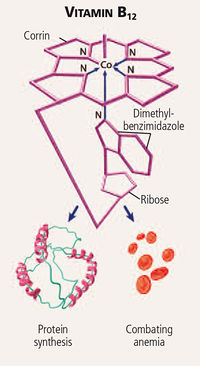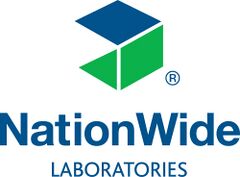Difference between revisions of "Vitamin B12 (Cobalamin) - Nutrition"
Fiorecastro (talk | contribs) |
|||
| Line 26: | Line 26: | ||
==Diagnosing Cobalamin Deficiency== | ==Diagnosing Cobalamin Deficiency== | ||
Diagnosis of cobalamin deficiency is based on presence of low fasted serum cobalamin level. If the patient is not fasted prior to testing, falsely increased cobalamin concentrations may be noted. [[Nutrition Glossary#Megaloblastic Anaemia|Megaloblastic anaemia]] and [[neutropenia]] with hypersegmentation may be seen on haematology profile. Diagnosis is also made on clinical signs consistent with deficiency and evaluation of diet. | Diagnosis of cobalamin deficiency is based on presence of low fasted serum cobalamin level. If the patient is not fasted prior to testing, falsely increased cobalamin concentrations may be noted. [[Nutrition Glossary#Megaloblastic Anaemia|Megaloblastic anaemia]] and [[neutropenia]] with hypersegmentation may be seen on haematology profile. Diagnosis is also made on clinical signs consistent with deficiency and evaluation of diet. | ||
| + | |||
| + | == Vitamin B12 and Folate == | ||
| + | Serum vitamin B12 and folate concentrations may be useful in diagnosing small intestinal disease in dogs and cats. Historically, the tests have also been used for diagnosis of small intestinal bacterial overgrowth/antibiotic responsive diarrhoea, but the characteristics of these conditions and the clinical utility of the tests for this specific purpose is a source of controversy. A single serum sample is required. | ||
| + | {| class="wikitable" | ||
| + | |+ | ||
| + | !Abnormality | ||
| + | !Interpretation | ||
| + | |- | ||
| + | |Low folate | ||
| + | |Disease of the proximal small intestine | ||
| + | |- | ||
| + | |Low Vitamin B12 | ||
| + | |Disease of the distal small intestine, EPI | ||
| + | |- | ||
| + | |Low/normal Vitamin B12 with high folate | ||
| + | |SIBO/ARD. Folate is normal or increased with EPI | ||
| + | |} | ||
| + | Test Codes - Please visit www.nwlabs.co.uk or see our current price list for more information | ||
==References== | ==References== | ||
<references/> | <references/> | ||
| − | + | <br>13. Vitamin B12 and Folate [[NationWide Laboratories]] | |
{{Reviewed Nutrition 1 | {{Reviewed Nutrition 1 | ||
|date = 22 May 2015}} | |date = 22 May 2015}} | ||
{{Waltham}} | {{Waltham}} | ||
{{OpenPages}} | {{OpenPages}} | ||
| + | |||
| + | [[File:NationWide Logo.jpeg|right|link=https://www.nwlabs.co.uk/|alt=NationWide Logo|240x240px|In Partnership with NationWide Laboratories|frameless|thumb|]] | ||
[[Category:Vitamins]] | [[Category:Vitamins]] | ||
Revision as of 10:50, 25 March 2022
What is Vitamin B12 (Cobalamin)?
Vitamin B12, is an essential cobalt-containing water-soluble vitamin. Cobalamin is the preferred name for the family of vitamins known as vitamin B12. It is synthesised by bacteria in the large intestine of cats and dogs, however the site of synthesis is caudal to the site of absorption making cobalamin a required dietary nutrient[1]. Cobalamin in the diet is bound to protein as either methylcobalamin or adenosylcobalamin and must be cleaved and subsequently bound to an endogenously synthesised glycoprotein called intrinsic factor (IF). Intrinsic factor is produced in the stomach and pancreas of dogs[2], but exclusively in the pancreas in cats[3]. Mucosal receptors for IF are found in highest concentration the ileum of dogs and cats. After binding of IF, cobalamin is dissociated and absorbed by the enterocyte, where it is then primarily bound to another glycoprotein (transcobalamin II) for transport in the blood[1]. Cobalamin is primarily stored in the liver and freely excreted through the renal tubules.
Why is it Important?
Cobalamin in the form of methylcobalamin and adenosylcobalamin are cofactors required for reactions involved in single-carbon transfer and fatty acid metabolism.
Roles in the Body
- Carbon Transfer: Cobalamin is a cofactor for methionine synthase, used to transfer a methyl group to homocysteine and regenerate methionine and tetrahydrofolate.[1][4].
- Propionate Metabolism: Propionyl-CoA is created during catabolism of specific amino acids (i.e. isoleucine, valine, methionine and threonine) as well as mitochondrial β-oxidation of odd-chain fatty acids[4]. Propionyl-CoA is then converted to methylmalonyl-CoA via the biotin-containing enzyme proprionyl-CoA carboxylase. The cobalamin-dependant enzyme, methylmalonyl-CoA mutase, then converts methylmalonyl-CoA to succinyl-CoA, which can feed into the tricarboxylic acid (TCA) cycle, be used for heme synthesis, or as a carbon skeleton for gluconeogenesis.
Consequences of Cobalamin Deficiency
Dogs:
Puppies affected by an inherited defect in cobalamin absorption develop inappetance and lethargy; hyperammonaemia and associate neurological signs[5]; neutropenia with hypersegmentation and megaloblastic anaemia[6]. Adult dogs with chronic intestinal disease can develop impaired cobalamin absorption either due to the primary intestinal disease or bacterial dysbiosis[7]. Clinical signs of hypocobalaminaemia in adult dogs are similar to that of the underlying intestinal disorder (e.g. diarrhoea and weight loss); the presence of hypocobalaminaemia in dogs with chronic enteropathies is a negative prognostic indicator[8].
Cats:
Kittens weaned onto a cobalamin deficient diet will initially grow normally, then will cease growing and begin lose weight after 3-4 weeks[9]. Similar to dogs, adult cats with chronic intestinal disease can develop cobalamin deficiency resulting in worsening vomiting, diarrhoea, and weight loss[10][11][12]. Cobalamin absorption requires binding to IF and active absorption in the ileum, therefore diseases affecting the pancreas (i.e., altered IF production) and/or the gastrointestinal tract (i.e., defects in the IF receptor or in the binding of IF to the IF receptor) can result in clinical cobalamin deficiencies despite adequate dietary intake.
Toxicity
There are no published reports of oral cobalamin toxicity in dogs and cats.
Dietary Sources
Cobalamin found in animal proteins, including muscle meat, organ meat, dairy, and eggs; it is absent in plant ingredients. Dogs fed vegetarian diets are at risk of deficiency unless adequately supplemented. Cobalamin is typically supplemented in commercially-prepared complete and balanced dog and cat foods.
Diagnosing Cobalamin Deficiency
Diagnosis of cobalamin deficiency is based on presence of low fasted serum cobalamin level. If the patient is not fasted prior to testing, falsely increased cobalamin concentrations may be noted. Megaloblastic anaemia and neutropenia with hypersegmentation may be seen on haematology profile. Diagnosis is also made on clinical signs consistent with deficiency and evaluation of diet.
Vitamin B12 and Folate
Serum vitamin B12 and folate concentrations may be useful in diagnosing small intestinal disease in dogs and cats. Historically, the tests have also been used for diagnosis of small intestinal bacterial overgrowth/antibiotic responsive diarrhoea, but the characteristics of these conditions and the clinical utility of the tests for this specific purpose is a source of controversy. A single serum sample is required.
| Abnormality | Interpretation |
|---|---|
| Low folate | Disease of the proximal small intestine |
| Low Vitamin B12 | Disease of the distal small intestine, EPI |
| Low/normal Vitamin B12 with high folate | SIBO/ARD. Folate is normal or increased with EPI |
Test Codes - Please visit www.nwlabs.co.uk or see our current price list for more information
References
- ↑ 1.0 1.1 1.2 National Research Council (NRC). Vitamins. In Nutrient Requirements for Dogs and Cats. 2006 Washington, DC: National Academies Press p.225-227.
- ↑ Batt RM and Horadagoda NU. Gastric and pancreatic intrinsic factor-mediated absorption of cobalamin in the dog. Am J Physiol 1989;257:G344-G349.
- ↑ Fyfe JC. Feline intrinsic factor (IF) is pancreatitic origin and mediates ileal cobalamin (CBL) absorption. JVIM 1993;7:133.
- ↑ 4.0 4.1 Shane B. Folic Acid, Vitamin B12, and Vitamin B6. In Biochemical and physiological aspects of human nutrition. 2000 Philadelphia, PA: WB Saunders Company p. 500-511.
- ↑ Battersby IA, et al. Hyperammonaemic encephalopathy secondary to selective cobalamin deficiency in a juvenile Border collie. JSAP 2005;46:339-344.
- ↑ Fyfe JC, et al. Inherited selective intestinal cobalamin malabsorption and cobalamin deficiency on the dog. Pediatr Res 1991;29:24-31.
- ↑ Berghoff N, et al. Serum cobalamin and methylmalonic acid concentrations in dogs with chronic gastrointestinal disease. AJVR 2013;74:84-89.
- ↑ Allenspach K, et al. Chronic enteropathies in dogs: evaluation of risk factors for negative outcome. JVIM 2007;21:700-708.
- ↑ Morris, J.G. Idiosyncratic nutrient requirements of cats appear to be diet-induced evolutionary adaptations. Nutr Res Rev 2002;15; 153-168.
- ↑ Vaden SL, et al. Cobalamin deficiency associated with methymalonic aciduria in a cat. JAVMA 1992;200:1101-1103.
- ↑ Simpson KW, et al. Subnormal concentrations of serum cobalamin (vitamin B12) in cats with gastrointestinal disease. JVIM 2001;15:26-32.
- ↑ Ruaux CG, et al. Early biochemical and clinical responses to cobalamin supplementation in cats with signs of gastrointestinal disease and severe hypocobalaminemia. JVIM 2005;19:155-160.
13. Vitamin B12 and Folate NationWide Laboratories
| This article was: Date reviewed: 22 May 2015 |
| Endorsed by WALTHAM®, a leading authority in companion animal nutrition and wellbeing for over 50 years and the science institute for Mars Petcare. |
Error in widget FBRecommend: unable to write file /var/www/wikivet.net/extensions/Widgets/compiled_templates/wrt694a1702be54f2_18714775 Error in widget google+: unable to write file /var/www/wikivet.net/extensions/Widgets/compiled_templates/wrt694a1702c3b880_19603206 Error in widget TwitterTweet: unable to write file /var/www/wikivet.net/extensions/Widgets/compiled_templates/wrt694a1702c9f432_08506071
|
| WikiVet® Introduction - Help WikiVet - Report a Problem |

